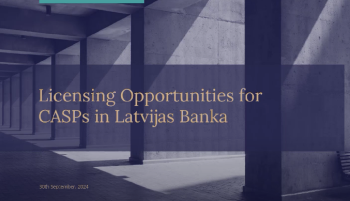MiCA Regulation
In May 2023, the Council of the European Union (EU) adopted the Regulation on markets in crypto-assets (MiCA), establishing a single EU-level legal framework for this industry. The Regulation applies from 30 December 2024.
On 13 July 2024, Latvia adopted the Law on Crypto-asset Services, which complements the MiCA Regulation and designates Latvijas Banka as the responsible supervisory authority for the crypto-asset segment. The law stipulates licensing and supervision fees for crypto-asset service providers, the obligations and rights of supervised market participants, etc.
The law provides that, as of 30 December 2024, Latvijas Banka issues authorisations to crypto-asset service providers and supervises their activities.
Furthermore, authorisation obtained by crypto-asset service providers in one EU Member State enables them to operate across the entire EU as provided for by the cross-border notification mechanism set out in the MiCA Regulation.
The aim of the MiCA framework is to create a completely new and unitary crypto-asset regulatory regime in all EU Member States, to promote innovation development and wider use of distributed ledger technology (DLT) while maintaining financial stability and protecting investors against risks.
Achieving these aims will enable the development and expansion of the number of companies operating in the rapidly growing crypto-asset sector in Latvia, within a secure and regulated environment.
MiCA is a component of the European Commission's digital finance strategy, designed to support the growth of digital finance while mitigating the related risks.
The MiCA framework applies to legal and natural persons and companies involved in crypto-asset issuance, offers to the public, admission to trading or providing services related to crypto-assets in the EU, and any transactions or activities related to crypto-assets.
The MiCA framework applies to all types of crypto-assets which are not covered by any existing legal acts of EU Member States governing financial services, including: asset-referenced tokens, e-money tokens and other crypto-assets other than asset-referenced or e-money tokens.
The purpose of this type of crypto-assets other than an e-money token is to maintain a stable value by referencing to any other value or rights or a combination thereof, including one or several official currencies.
An example of this type of crypto-asset is a relatively new type of crypto-assets, stablecoins. They may be pegged to several official currencies of the country (such as the US dollar, the euro), to assets (such as gold), to other types of crypto-assets or their basket to reduce price volatility.
This type of crypto-assets is linked exclusively to the official currency of a single country and is used for making payments or storing value, much like e-money. Under the Electronic Money Directive, all e-money tokens are classified as e-money; however, not all forms of e-money are classified as e-money tokens.
This group of crypto-assets encompasses a broad spectrum of crypto-assets – all other crypto-assets that are transferable, not irreplaceable, and have an identified issuer, provided they are not explicitly excluded from the scope of the MiCA Regulation. They also include utility tokens with the aforementioned characteristics.
The MiCA framework does not apply to crypto assets that are unique and non-fungible tokens, as well as crypto-assets that are classified as:
- financial instruments governed by Directive 2014/65/EU on markets in financial instruments (MiFID II);
- deposits (MiFID II);
- deposits qualifying as funds, excluding e-money tokens (Payment Services Directive);
- securitisation positions in the context of a securitisation;
- non-life/life insurance product;
- re-insurance and retrocession contracts;
- individual pension products and occupational pension schemes;
- social security schemes;
- crypto-assets issued by public authorities, central banks, the European Investment Bank, and other international organisations (central bank digital currencies);
- completely decentralised financial protocols;
- funds that are not classified as e-money tokens and are governed by Directive 2015/2366 on payment services in the internal market (PSD2).
The MiCA framework does not apply to the European Central Bank, EU national banks.
The MiCA framework provides legal clarity and certainty for crypto-asset issuers and crypto-asset service providers, by defining:
- transparency and disclosure requirements for crypto-asset issuance, offer to the public and admission to trading;
- the procedures for the authorisation of crypto-asset issuers and service providers and their supervision;
- operational, organisational, and governance requirements for crypto-asset issuers and service providers.
The MiCA framework sets out requirements and measures that provide protection for crypto-asset holders and customers of service providers (capital requirements, asset storage, mandatory complaint storage procedures available to investors and investor rights against the issuer).
Consultations with experts of Latvijas Banka
"*" indicates required fields



